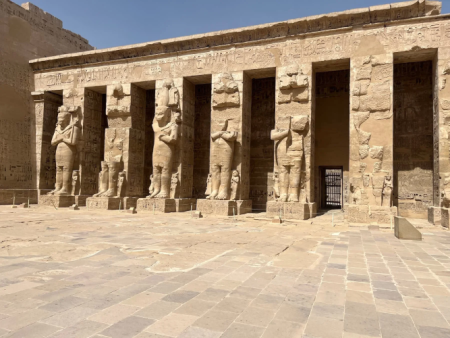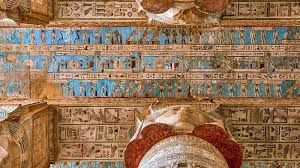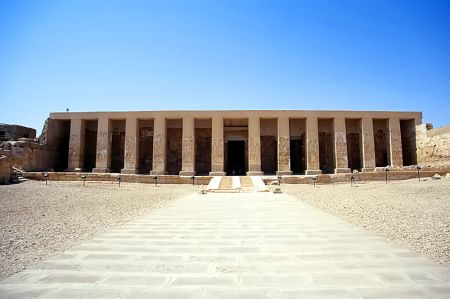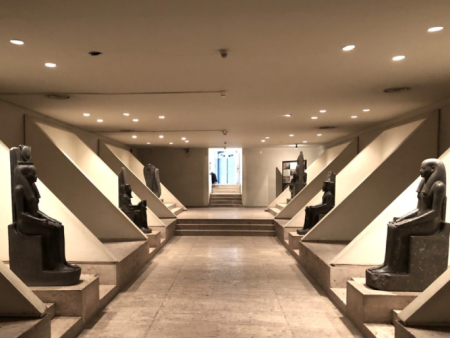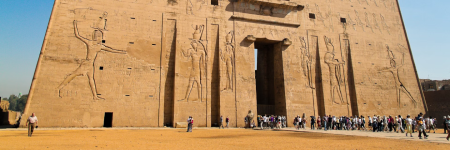Luxor Temple

Luxor Temple: The Timeless Gem of Ancient Egypt
Standing proudly on the east bank of the Nile River, Luxor Temple is one of Egypt’s most iconic monuments—a living testament to the glory of ancient Thebes and the unmatched artistry of pharaonic civilization. Built over 3,400 years ago, this magnificent temple complex is dedicated to the rejuvenation of kingship and the divine connection between gods and humans. Unlike other sanctuaries dedicated to particular deities, Luxor Temple focuses on the concept of divine kingship itself. Its colossal columns, intricate hieroglyphics, and graceful statues narrate stories of power, faith, and legacy, drawing millions of travelers to marvel at its grandeur.
Originally constructed under Amenhotep III and later expanded by Ramses II, Luxor Temple remains a masterpiece of ancient architecture. It forms part of the great Theban temples, along with the nearby Karnak Temple, connected through the legendary Avenue of Sphinxes. This sacred pathway once hosted grand processions during the annual Opet Festival, uniting gods, priests, and pharaohs in splendid ceremony. Today, visitors can still walk this ancient route, retracing the footsteps of powerful rulers who once called Thebes the heart of their empire.
The temple’s location in Luxor City makes it a center of attraction for history lovers, photographers, and spiritual travelers. Whether illuminated by the glowing desert sun or bathed in golden floodlights at night, Luxor Temple exudes an ethereal aura that captures the imagination. Its continuous use—from the time of the pharaohs through Roman occupation and even Islamic settlement—makes it not just a relic of the past but a living monument that has evolved with Egypt’s history. This captivating blend of eras makes Luxor Temple a must-see destination for anyone exploring Egypt Travel Packages.
The Historical Significance of Luxor Temple
Luxor Temple wasn’t built overnight; it’s a complex tapestry of architecture, religion, and royal ideology. Its origins date back to the 14th century BCE, during the reign of Amenhotep III, one of Egypt’s most prolific builders. The temple was later expanded by Ramses II, whose colossal statues still guard the entrance today. Tutankhamun and Horemheb also contributed to its adornment, while Alexander the Great added chapels during the Greco-Macedonian period, ensuring Luxor Temple remained a living symbol of divine power.
Unlike temples such as the Temple of Hatshepsut or the Abu Simbel Temples, which honor specific gods, Luxor Temple was dedicated to Amun-Ra’s incarnation on earth—the living pharaoh. During the Opet Festival, statues of deities were carried from Karnak to Luxor Temple to celebrate the renewal of royal and divine power. This symbolic journey reinforced the pharaoh’s legitimacy and strengthened the bond between gods and humans.
Architectural Layout and Artistic Excellence
Luxor Temple exemplifies ancient Egyptian architectural mastery. It begins with a massive pylon built by Ramses II, flanked by two seated statues of the pharaoh and once fronted by six obelisks—only one remains in place today, while its twin stands in Paris’s Place de la Concorde. Behind the gateway, a vast court filled with columns, reliefs, and statues leads visitors into an inner sanctuary that once held the sacred barque of Amun.
The temple’s design mirrors the concept of spiritual progression—from the outer world to the inner divine realm. Every column, relief, and carving echoes religious symbolism, emphasizing harmony between man and god. The Hypostyle Hall, adorned with lotus and papyrus capitals, represents the unification of Upper and Lower Egypt. Hieroglyphs depicting scenes of offerings, festivals, and coronations transform the stone into a living chronicle of ancient rituals.
Ramses II’s Contributions and Legacy
Ramses II, often called the “Great Builder,” left a bold mark on Luxor Temple. His additions include the grand pylon, colossal seated statues, and exquisite reliefs depicting the Battle of Kadesh. These depictions weren’t merely decorative—they were political propaganda, immortalizing his military prowess and divine right to rule. The pharaoh’s image, repeated endlessly, symbolized eternal kingship and divine protection over Egypt.
Religious Purpose and the Opet Festival
The annual Opet Festival was Luxor Temple’s crowning event, celebrating the fertility of the Nile and the rejuvenation of the pharaoh’s power. During this grand procession, the sacred barques of Amun, Mut, and Khonsu traveled from Karnak Temple to Luxor Temple, escorted by priests, musicians, and dancers. The festival, filled with joy and devotion, reaffirmed harmony between gods, kings, and nature. Today, archaeologists view these ceremonies as vital to understanding ancient Egyptian religion and its influence on art and governance.
Luxor Temple Through the Ages
Luxor Temple’s journey didn’t stop with the fall of the pharaohs. During Roman rule, the complex was transformed into a fortress and later a Christian church. In the 14th century CE, the mosque of Abu Haggag was built atop part of the temple, where it still functions today—an extraordinary symbol of continuity between ancient and modern faiths. This fusion of architectural eras makes Luxor Temple a profound example of Egypt’s living heritage.
The Symbolism and Spiritual Essence of Luxor Temple
The temple’s symbolism revolves around rebirth, divine kingship, and cosmic order. Its alignment with the Nile River reflects the cycle of life and eternity central to Egyptian cosmology. Each structure was positioned to capture sunlight during sacred moments, representing the eternal connection between heaven and earth. The temple’s inner sanctum, where the god Amun was believed to dwell, epitomized spiritual rebirth and the unity of divine and royal forces.
Moreover, Luxor Temple’s role extended beyond religion—it was a stage for political legitimacy. Pharaohs performed rituals here to renew their divine right to rule. The temple’s walls narrate not only myths but also historical events, embodying both spiritual and state authority. No wonder it continues to intrigue travelers and scholars exploring Egypt Nile Cruises today, as they uncover layers of history that connect ancient spirituality with modern exploration.
Exploring Luxor Temple Today: A Modern Pilgrimage
Visiting Luxor Temple is like stepping back through millennia. Travelers can explore its towering colonnades, walk the Avenue of Sphinxes, and witness the interplay of light and shadow across its hieroglyphic-covered walls. The temple is especially mesmerizing at sunset, when golden rays illuminate the sandstone, and at night, when strategic lighting transforms it into a celestial wonder. Many visitors pair their trip with excursions to the Valley of the Kings or the Colossi of Memnon, creating a complete immersion into Theban civilization.
Guided tours often highlight the temple’s symbolic carvings, secret chambers, and inscriptions that chronicle the evolution of Egyptian art. Whether you’re a historian, an adventurer, or a spiritual seeker, standing within Luxor Temple’s colossal colonnades feels like connecting with eternity.
Tips for Visiting Luxor Temple
For the best experience, visit Luxor Temple early in the morning or after sunset to avoid crowds and capture stunning photographs. Combine your visit with nearby attractions such as Luxor Museum or the Dandara Temple. Many Egypt Luxury Tours include evening excursions, offering a magical view of the temple illuminated against the starry desert sky. Don’t forget to stroll along the renovated Avenue of Sphinxes, which once connected two of Egypt’s greatest sanctuaries—Karnak and Luxor.
Frequently Asked Questions about Luxor Temple
When was Luxor Temple built?
Luxor Temple was built around 1400 BCE during the reign of Pharaoh Amenhotep III. It was later expanded by Ramses II and other rulers. Over centuries, it evolved through various dynasties and empires, each leaving a unique architectural mark that enriches its heritage.
What was the purpose of Luxor Temple?
The temple was dedicated to Amun-Ra and symbolized the divine aspect of kingship. It played a central role in the Opet Festival, during which the pharaoh’s spiritual strength was renewed, reinforcing his legitimacy as the earthly representative of the gods.
Where is Luxor Temple located?
Luxor Temple is located in modern-day Luxor City, on the east bank of the Nile River in Upper Egypt. It stands near the ancient site of Thebes and forms part of a greater complex of temples and tombs that stretch across both banks of the river.
Can visitors enter Luxor Temple at night?
Yes, Luxor Temple is open for evening tours. After sunset, it’s beautifully illuminated, casting dramatic shadows that accentuate its statues and columns. The night view offers a mystical experience unlike any daytime visit and is highly recommended for photographers and history enthusiasts.
What other attractions can be visited near Luxor Temple?
Nearby attractions include the vast Valley of the Kings, the majestic Temple of Hatshepsut, and the towering Colossi of Memnon. Many travelers also enjoy pairing their visit with scenic Best Nile River Cruises to fully appreciate the timeless charm of ancient Thebes from the water.





